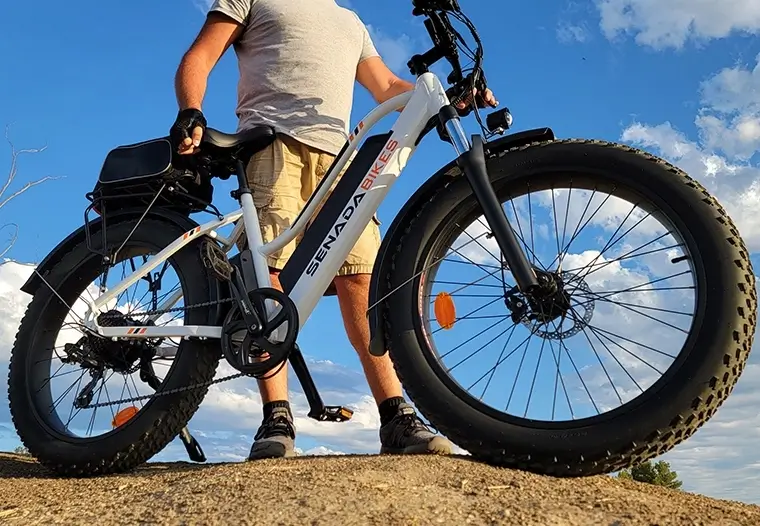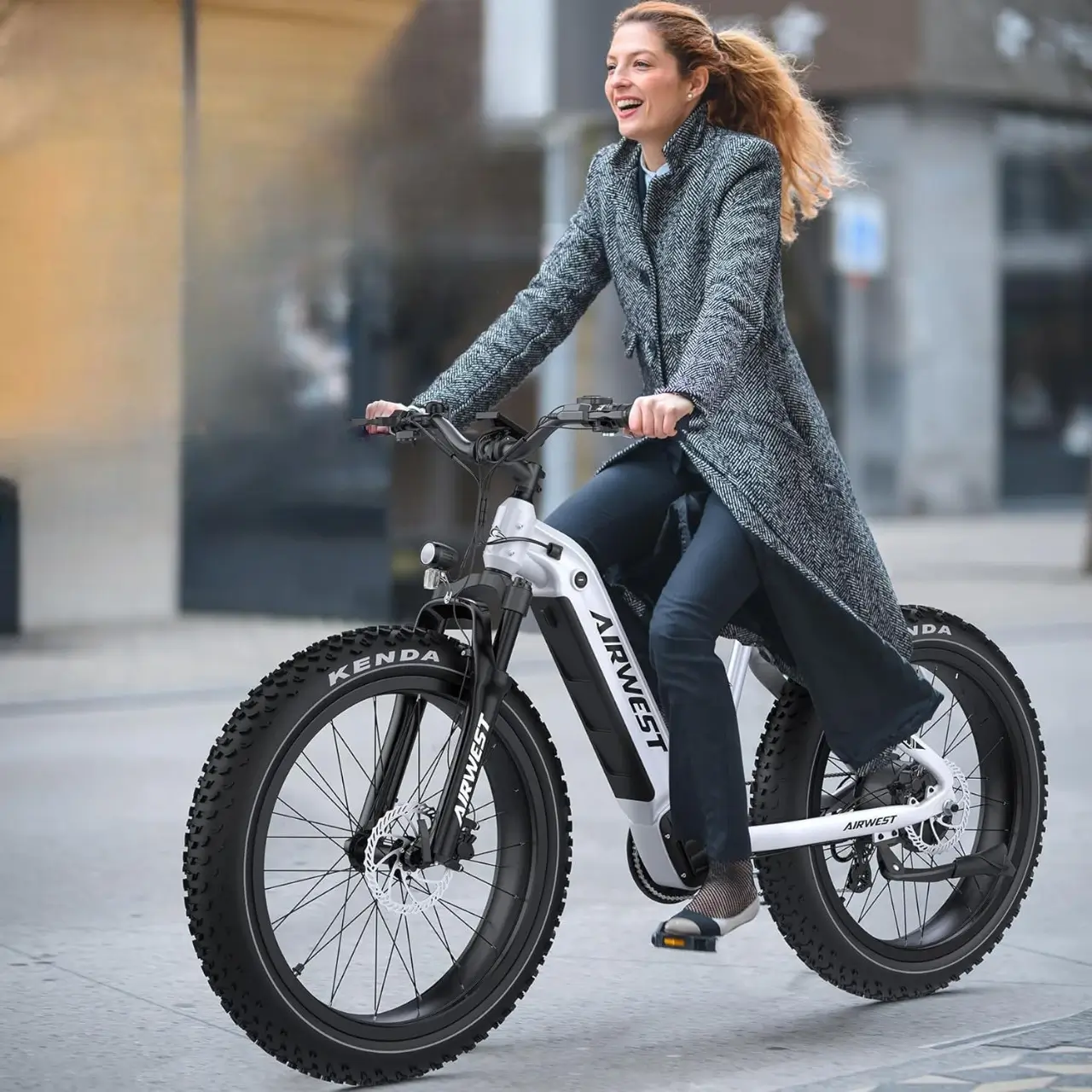Electric bikes have revolutionized urban commuting and outdoor adventures, offering an eco-friendly and efficient mode of transportation. Among the variations available, flat tire ebikes have gained attention for their unique design and performance.
But these burly beasts are not without their trade-offs. Before you hop on and cruise into the sunset, let’s take a balanced look at the pros and cons of fat tire electric bikes.
Pros of Flat Tire Ebikes
- Terrain Tamers
- Stability Champions
- Grip Masters
- All-Season Warriors
- Effortless Power
Cons of Flat Tire Ebikes
- Rolling Resistance Bullies
- Weighty Warriors
- Maintenance Monsters
- Pricey Ponies
- Storage Space Hogs
What is Flat Tire Ebikes
Flat tire ebikes, equipped with robust electric motors and sleek designs, present a compelling option for modern riders seeking enhanced convenience and versatility.
1. Sleek Designs for Urban Maneuverability
The streamlined structure of flat tire ebikes allows for agile navigation through crowded urban spaces. Their compact build facilitates easy storage, making them ideal for commuters living in compact quarters.

2. Robust Electric Motors for Enhanced Performance
These bikes boast powerful electric motors, providing riders with an effortless and speedy ride. The motor’s efficiency ensures a seamless riding experience, particularly on flat terrains.
3. Lightweight Frame for Easy Handling
With a focus on portability, flat tire ebikes feature lightweight frames that offer ease of handling and transport. This feature makes them a preferred choice for users who may need to carry their bikes over short distances.
4. Energy Efficiency for Extended Rides
The electric-powered mechanism of flat tire ebikes contributes to their impressive energy efficiency. Riders can cover considerable distances without worrying about draining the battery quickly.
Pros and Cons of Ebikes with Flat Tires
5 Pros of Ebikes with Flat Tires
1. Terrain Tamers
Fat tires provide unparalleled traction on loose surfaces like sand, snow, and mud. They conquer rough terrain with ease, allowing you to explore beyond the limits of regular bikes.
2. Stability Champions
The wider tires act as mini shock absorbers, smoothing out bumps and offering a more comfortable ride. This makes them ideal for beginners or those who want a confidence-boosting experience.
3. Grip Masters
The increased contact patch translates to superior grip, especially on wet or loose surfaces. This translates to better control and braking, making them safer in challenging conditions.
4. All-Season Warriors
Fat tire e-bikes aren’t afraid of bad weather. They roll through snowdrifts, navigate muddy trails, and handle wet roads with confidence, making them year-round companions.
5. Effortless Power
The electric motor provides pedal assistance, making tackling hills and long distances a breeze. This opens up cycling to those with limited fitness levels or who want a more leisurely ride.
5 Cons of Flat Tire Ebikes
1. Rolling Resistance Bullies
The sheer mass of the tires creates significant rolling resistance, especially on paved roads. This translates to lower top speeds and reduced efficiency, impacting battery range.
2. Weighty Warriors
Fat tire e-bikes are heavier than their standard counterparts, making them less nimble and more cumbersome to maneuver in tight spaces or lift onto bike racks.

3. Maintenance Monsters
The wider tires and heavier components require more frequent maintenance, potentially increasing your costs and time investment.
4. Pricey Ponies
Fat tire e-bikes tend to be more expensive than regular e-bikes, due to the specialized components and larger motors required to overcome the increased rolling resistance.
5. Storage Space Hogs
Finding storage for a bulky fat tire e-bike can be a challenge, especially in apartments or with limited space.
Fat tire e-bikes are a unique breed, offering unparalleled versatility and confidence on challenging terrain. They’re ideal for adventurers, off-road enthusiasts, and those seeking a comfortable ride in all conditions.
However, their weight, efficiency limitations, and higher price point might deter urban commuters or those who prioritize speed and agility.
Ultimately, the choice comes down to your needs and riding preferences. If you crave exploration, conquer rough terrain, and enjoy a comfortable ride, a fat tire e-bike might be your perfect match. But if you prioritize speed, efficiency, and urban riding, a standard e-bike might be a better fit.
Remember Take a test ride on both types of e-bikes before making your decision. And most importantly, enjoy the ride, regardless of the tire width!
Bonus Tip
Consider the tire size and pressure. Narrower tires and lower pressure offer better on-road performance, while wider tires and higher pressure provide better off-road traction. Pick in view of your riding style and territory inclinations.
Conclusion
Flat tire ebikes offer a blend of agility, efficiency, and eco-friendliness, making them an appealing choice for urban commuting and shorter rides. However, their specialized design poses certain limitations, particularly on challenging terrains and in terms of maintenance. Understanding these nuances helps riders make informed choices that align with their preferences and riding needs
I hope this article gives you a clear picture of the pros and cons of fat tire electric bikes. Now, go forth and conquer those hills, mud puddles, and any other terrain that stands in your way!
FAQs
How durable are the tires of flat tire ebikes?
The durability of the tires varies based on usage and terrain. While they can withstand regular urban conditions, they might be less resilient on harsh terrains.
Are flat tire ebikes suitable for beginners?
Riders with some experience might find flat tire ebikes easier to handle in urban settings, but beginners may need some adjustment due to the unique tire design.
Do flat tire ebikes require specialized maintenance?
Maintaining these bikes might require specialized tools for tire repairs, which might not be readily available at standard bike repair shops.
Can flat tire ebikes be used in rainy conditions?
While these bikes can be used in light rain, caution is advised as the specialized tire design might offer less traction on wet surfaces.
Are there variations in the flat tire design among different manufacturers?
Yes, manufacturers might employ different materials and designs for their flat tires, impacting factors like durability and performance.




